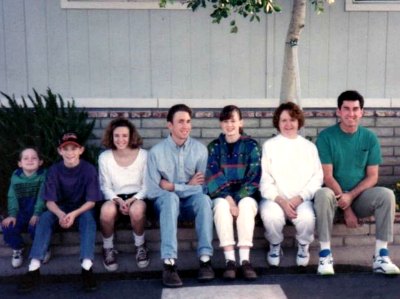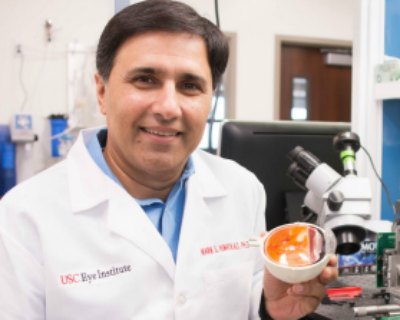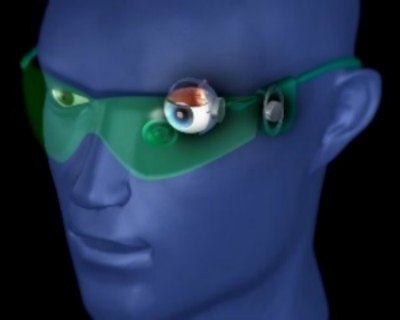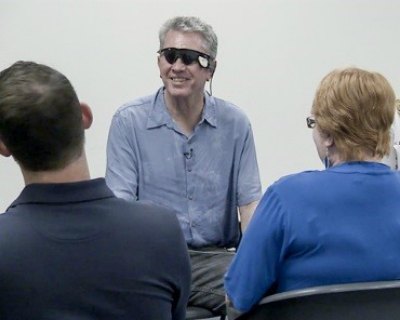Ophthalmologist Turns Science Fiction Into Science Fact
Father-of-four Terry Byland was just 37 years old and was falling for his wife-to-be Sue when he began having problems seeing at night. His vision worsened and he started bumping into things.
Soon after their wedding, Terry went to see doctors to seek help and received a devastating diagnosis. They told him he had a degenerative eye disease for which there was no treatment or cure. Seven years later, Terry lost his vision completely.
For many years, Terry worked hard to adjust to living without sight and had accepted he would never see again. Then, one day, he learned an ophthalmologist, Mark S. Humayun, MD, PhD had co-invented a device that might one day help people who have been blinded by his condition regain some sense of sight.
Terry inquired with Dr. Humayun about participating in a clinical trial to test the device. It would be his first step in helping to make possible something that could change not only his life but also those of thousands of people around the world affected by his condition and future generations to come.
The Diagnosis: Retinitis Pigmentosa

Terry with his family.
Terry, now 67, lost his sight due to retinitis pigmentosa, a group of genetic defects that damage the retina, which is the light-sensitive tissue at the back of the eye. It is estimated that approximately 1.5 million people worldwide have the condition, including 100,000 in the United States. The symptoms typically start with poor night vision, then a loss of peripheral vision, progressing to tunnel vision and then complete blindness.
Adjusting to life without vision was understandably difficult for Terry.
"It was very, very tough – very hard. Your life is changing forever. You lose your ability to make a living. You can't see your wife. You can't see your children. You can't see to get around. You think the world's coming to an end. It was all bad. There was nothing good about it at that time – depression, anxiety, being mad one minute and going out of my mind the next,” Terry said.
“Your life is changing forever. You lose your ability to make a living. You can't see your wife. You can't see your children. You can't see to get around. You think the world's coming to an end.” – Terry Byland
Managing Without Sight
Terry found help at his local Braille Institute. “[Before I had vision problems] I'd see people out there with their guide dogs and canes and I felt sorry for them,” he said. “Little did I know I'd be over there…I went over there and met some other blind people and learned all the things I needed to learn to try to cope with it and how to deal with it.”
This included becoming more self-sufficient and learning how to take the bus rather than relying solely on Sue for transportation. The Braille Institute also encouraged Terry to try things he never dreamed blind people could do. They went to the movies, bowling and even line dancing.
“When I was at home, I knew there were a lot of blind people out there, but I felt like I was on an island by myself. When I started meeting these people [at the Braille Institute], men and women both there…the anger started to slowly leave…It took me almost a whole year after I went blind before I could actually feel like, ‘Hey, I'm going to make it. I'm going to beat this thing. I'm going to do whatever it takes.’"
"I'm going to make it. I'm going to beat this thing. I'm going to do whatever it takes” – Terry Byland
Testing the Argus I and Argus II – The “Bionic Eye”

Dr. Humayun in his lab.
In 2004, Sue heard that a doctor had created a device that could help people like Terry. It was Dr. Humayun, professor of ophthalmology and biomedical engineering at USC and co-director of the USC Roski Eye Institute as well as Director of the USC Institute for Biomedical Therapeutics. Dr. Humayun determined Terry and found he was a suitable candidate for a clinical trial to test a device that would eventually become the first FDA-approved retinal prosthesis for RP.
Terry was one of the people to test the Argus I and Argus II in clinical trials that helped pave the way for FDA approval of the Argus II. He also became the first to have both devices implanted.
Nicknamed the ‘Bionic Eye’, the Argus II system has three parts, a small electronic device implanted in and around the eye, a tiny video camera attached to a pair of glasses and a video processing unit that is worn or carried by the patient. The camera sends a signal to the video processor, which then wirelessly sends the signal to an electronic receiver with 60 electrodes implanted inside the eye. The implanted receiver sends signals via an electrode array to the retina. These signals are then relayed through the optic nerve to the brain, where they can be interpreted as a visual information.

Illustration of the Argus II.
Through the device, patients with retinitis pigmentosa are able to see patterns of light that the brain learns to interpret as an image.
“When I first met Terry, I knew right off the bat that he was somebody very special because he wanted to enroll in this for altruistic reasons,” Dr. Humayun said. “He told me basically, I want to progress the science, so some day it will help someone else.”
Terry’s attitude was important, Dr. Humayun said. Participants in the study needed to be realistic about what the device could do and could not do. And, although the impact of the Argus II on his sight was limited, it was still life-changing to him.
“They said, ‘We're turning it on, now,’ and boom. There it was, this little pinpoint of light,” Terry said. “I thought, ‘Wow, I'm actually seeing that. I’m actually seeing something other than just darkness.’”
Thanks to the Argus II, Terry is able to see people’s silhouettes in bright light. He can see some movement and some of what’s happening on a television monitor or movie screen. Last July, for the first time since he went blind, Terry saw fireworks.
"They said, ‘We're turning it on, now,’ and boom. There it was, this little pinpoint of light,” Terry said. “I thought, ‘Wow, I'm actually seeing that. I’m actually seeing something other than just darkness.’” – Terry Byland describing seeing for the first time with the Argus II
The ability to see forms helps Terry when he goes out alone and needs to walk to a destination. The Argus II allows him to get from one point to another faster, in familiar areas such as his route to the senior center.
“There are certain physical landmarks – posts and stuff that you can see with this device. It gives me a very big advantage that I can see some of these things,” he said.
This is an incredible feat in medicine and technology. Earlier this year, President Barak Obama awarded Dr. Humayun with the National Medal of Technology and Innovation for co-creating the device, calling it and the work of the other award winners a “testament to American ingenuity.”
“The ability to restore sight to somebody who is blind from degenerative retinal conditions is not something we're used to,” Dr. Humayun said. “It's something that using our current treatment modalities never happens. To be able to put a device in the first blind patient and then have him see a spot of light remains the most exciting day of my professional career…What we’ve done is taken this concept that many considered to be science fiction and made it science fact.”
"What we’ve done is taken this concept that many considered to be science fiction and made it science fact.” - Dr. Mark Humayun
A Renewed Passion for Life
Terry’s work on Argus I and II has given him a passion for life that he once feared he’d lost for good.
“A blind person’s life can be somewhat mundane sometimes and this has really given me a solid reason to go on and to look forward, knowing I’m taking part in something that’s going to affect a lot of people in a positive way,” said Terry.
Sue agreed. “He's becoming more his old self, that he feels like he's needed, and he doesn't have to have me, or our son, or something to be there for him,” said Sue. “He's become more independent, and more able to get around. In fact, he's assisting a Sunday School class with the four-year-olds at our church.”
Of course, Terry hopes that that future will include him and he’ll one day be able to clearly see the faces of his loved ones, and not just their forms and movement.
“He's becoming more his old self… He's become more independent, and more able to get around.” – Sue Byland, Terry’s wife
The Road Ahead For the Argus
Dr. Humayun and Terry say that the Argus II is just the “tip of the iceberg.”

Terry seeing for the first time with the Argus II.
“I can’t see the way I saw so many years ago, but I can tell where you’re at. It’s something. It’s a beginning,” said Terry.
Dr. Humayun imagines future iterations of the Argus will have better cameras and more powerful chips enabling a higher resolution image and possibly color perception.
The device is also being tested for use in people who have lost their vision to age-related macular degeneration.
Terry looks forward to these developments helping make better lives for people with RP.
“It’s all about the future…people getting it, being able to use the device and to have a much richer life,” he said.
“I can’t see the way I saw so many years ago, but I can tell where you’re at. It’s something. It’s a beginning…It’s all about the future…people getting it, being able to use the device and to have a much richer life.” – Terry Byland